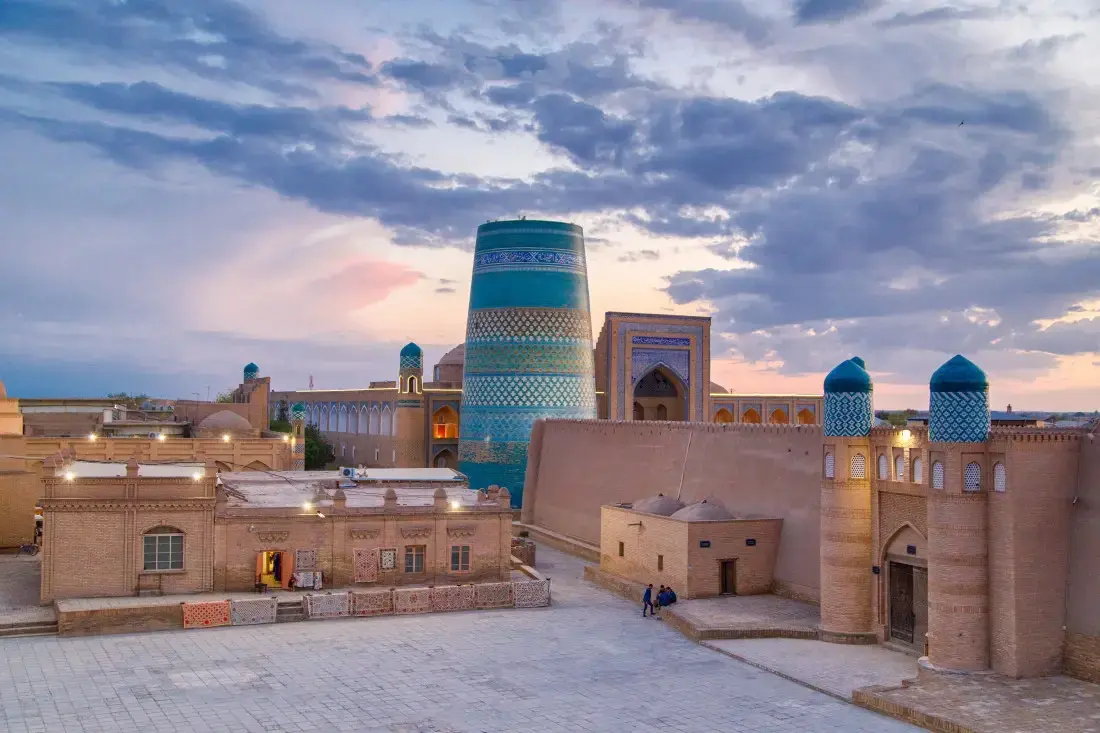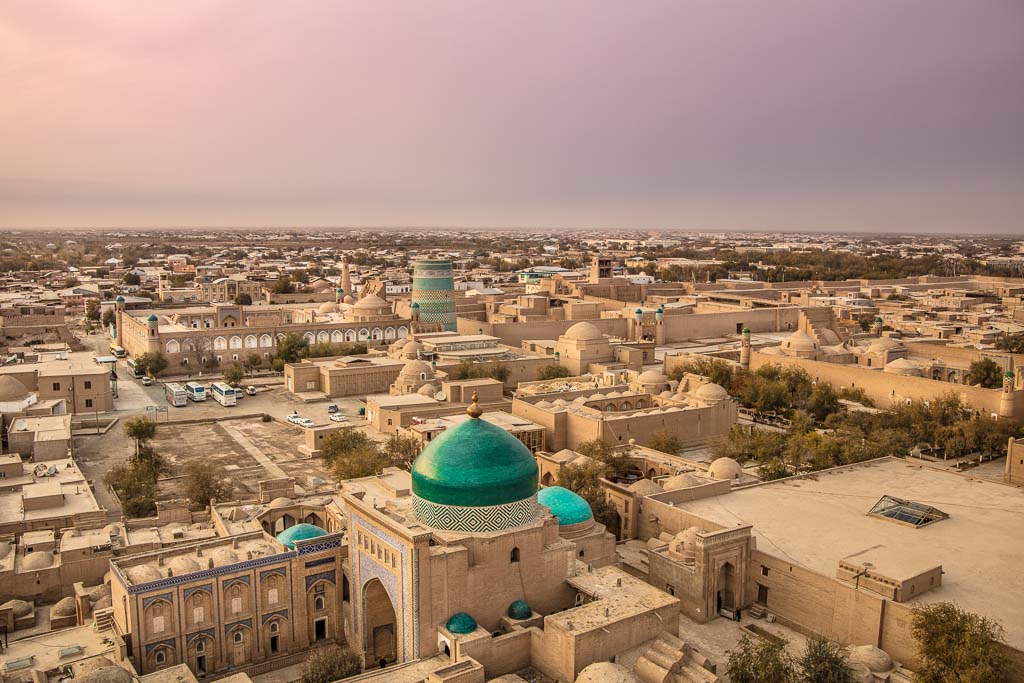



Khiva is a district-level city of approximately 93,000 people in Khorazm Region, Uzbekistan. According to archaeological data, the city was established around 2,500 years ago. In 1997, Khiva celebrated its 2500th anniversary.
The best time to visit Khiva is during the spring (April to early June) and autumn (September to early November) months. These seasons offer the most pleasant weather, ideal for exploring the city's historical sites and outdoor attractions.
Weather: Temperatures are mild, ranging from 15°C to 25°C (59°F to 77°F), making it comfortable to walk around the city and explore its sights.
Advantages: The city is less crowded than in summer, and the gardens and parks are in full bloom, adding to the beauty of Khiva.
Ideal for: Sightseeing, outdoor activities, and exploring the Silk Road sites.
Weather: Temperatures are also mild, ranging from 20°C to 30°C (68°F to 86°F) in September, cooling down to 10°C to 20°C (50°F to 68°F) by November.
Advantages: The harvest season adds a unique touch, and the weather is still pleasant. It’s a great time to experience local food and enjoy the vibrant colors of autumn.
Ideal for: Cultural exploration, photography, and enjoying the outdoor markets.
Weather: Khiva experiences extremely hot temperatures, often exceeding 40°C (104°F), especially in July and August. The heat can be intense and uncomfortable for extended outdoor activities.
Disadvantages: The heat can make sightseeing less enjoyable, and many outdoor attractions may feel overwhelming under the midday sun.
Ideal for: If you prefer fewer crowds and can handle the heat, but otherwise, it’s best to avoid the summer months.
Weather: Winter temperatures can drop to 0°C (32°F) or lower, especially in January, with occasional snow. It’s cold, but the city is quieter, and you can enjoy indoor cultural activities.
Advantages: You’ll have the city to yourself, and hotel rates tend to be lower.
Disadvantages: The cold weather can make sightseeing less pleasant, and some attractions may have shorter visiting hours or be closed.
Best Time to Visit: Spring (April to June) and Autumn (September to November) for comfortable weather and a balance between great sightseeing and fewer tourists.
By Air: Khiva doesn't have an international airport, but it is accessible via flights to Urgench Airport (around 35 km away), which has domestic flights from Tashkent, Samarkand, and Bukhara. From Urgench, you can take a taxi or shuttle to Khiva.
By Train: Khiva is also accessible by train from major cities like Tashkent, Bukhara, and Samarkand. Trains to Urgench station (near Khiva) run regularly, and from there, it's a short ride to Khiva.
By Road: You can travel by bus or private car from cities like Bukhara (around 5 hours away) or Samarkand (about 8 hours). The journey is long but offers an opportunity to see the rural landscape of Uzbekistan.
Itchan Kala (The Old Town): A UNESCO World Heritage site, Itchan Kala is a stunning walled city that showcases Khiva's rich history. Its narrow streets, ancient madrasahs, mosques, and minarets make it feel like stepping back in time.
Kalta Minor Minaret: One of Khiva’s most iconic landmarks, the Kalta Minor Minaret, is famous for its unfinished structure and vibrant blue tilework. It's a symbol of Khiva's architectural grandeur.
Juma Mosque: Known for its unique wooden pillars, this mosque features 218 wooden columns, many of which are centuries old.
Kunya-Ark Fortress: This fortress was the former residence of Khiva’s rulers. It houses a museum and offers stunning views of the city from its ramparts.
Tash Khauli Palace: A beautiful palace complex with intricately designed courtyards, rooms, and a harem. The palace is known for its detailed tilework and elegant architecture.
Pahlavan Mahmud Mausoleum: This mausoleum is dedicated to the famous poet and warrior Pahlavan Mahmud, and it features striking blue tiles and intricate design.
Islam Khodja Complex: The tallest building in Khiva, this complex includes a mosque and a minaret, offering panoramic views of the old town.
Wander Through Itchan Kala: The best way to experience Khiva is on foot, walking through the maze of narrow streets, admiring the historical buildings, and getting lost in the atmosphere of the ancient city.
Visit the Khiva Bazaars: Like most Central Asian cities, Khiva has bustling bazaars. You can shop for local handicrafts, including carpets, textiles, and ceramics, as well as spices and dried fruits.
Take a Sunset View from the Minaret: Climb to the top of the Islam Khodja Minaret for a beautiful sunset view of Khiva’s old town. The panoramic view of the city and surrounding desert is unforgettable.
Relax in the Hammam: Experience the traditional bathhouse culture of Central Asia by visiting a local hammam (bathhouse) for a relaxing and rejuvenating experience.
Cultural Performance: Khiva often holds cultural performances, including traditional music and dance. These are great opportunities to experience local art and culture.
Luxury:
Orient Star Khiva: A modern hotel housed in a historical building with an authentic feel, offering comfort and a good location near the old town.
Hotel Asia Khiva: A more upscale option with great amenities, including an outdoor pool and traditional decor, located close to the historic city center.
Mid-Range:
Zarafshan Hotel: Located near the city center, this hotel offers comfortable rooms and good service at a reasonable price.
Khiva Hotel: A charming boutique hotel offering traditional decor and a cozy atmosphere, with easy access to the main attractions.
Budget:
Guesthouses: There are plenty of guesthouses around the old town that offer budget-friendly accommodation. Popular options include Suhrob's Guesthouse and Khiva Hostels for travelers looking to keep costs low.
Plov (Pilaf): A staple of Uzbek cuisine, plov is often made with lamb, rice, carrots, onions, and a variety of spices. Khiva offers a unique version of plov that you can try at local restaurants.
Samsa: Savory pastries filled with meat or vegetables, samsa are a favorite street food in Khiva and throughout Uzbekistan.
Shashlik: Grilled skewers of meat (often lamb or chicken), served with flatbread, fresh salads, and vegetables.
Lagman: A noodle soup served with meat, vegetables, and spices, which is a popular dish throughout Central Asia.
Top restaurants:
Terrassa: A rooftop restaurant offering beautiful views of Khiva, where you can enjoy traditional Uzbek dishes, including plov and shashlik.
Khiva Café: A charming place to try local specialties like samsa and lagman.
Sufi Restaurant: Known for its local specialties and traditional Uzbek atmosphere.
Islamic Influence: Like the rest of Uzbekistan, Khiva has a deep Islamic heritage, and its architecture reflects this with many mosques, madrasahs, and mausoleums. Islam remains an important part of local life.
Silk Road Legacy: Khiva was once a key stop on the Silk Road, and the city’s historical significance as a trading hub is still evident in its architecture, markets, and culture.
Hospitality: Uzbek hospitality is legendary, and locals in Khiva are very welcoming. It’s common for visitors to be invited for tea, and you may even be offered a meal by locals.
Craftsmanship: Khiva is known for its traditional handicrafts, including ceramics, carpet weaving, and silk production. You’ll find numerous artisans selling their goods in the city’s bazaars.
Traditional Music and Dance: Khiva is a great place to experience Uzbek music, including maqom (classical music), and traditional dance performances. These are often part of cultural festivals or held at local venues.